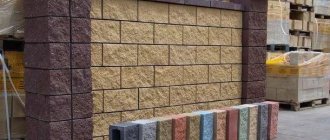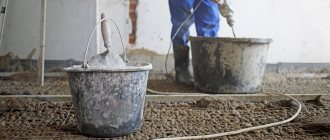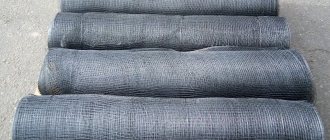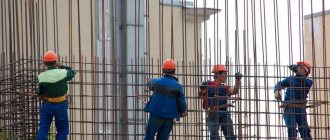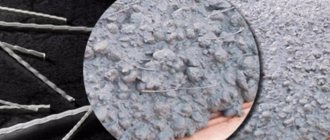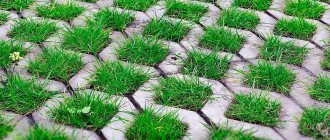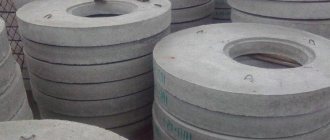Beton-House.com
Website about concrete: construction, characteristics, design. We combine the experience of professionals and private craftsmen in one place
Reinforcement of structures
Mesh for concrete reinforcement is the most important element of reinforced concrete structures, serving to strengthen the structure of the product. Accordingly, the characteristics of the structure as a whole largely depend on its quality.
Reinforcement of concrete with mesh is an effective protection of coatings from cracks and other unwanted defects that arise during the construction or operation of structures. How it is performed, and on what principle the elements for internal reinforcement of concrete are selected, will be described in this article.
Why do you need reinforcing mesh?
Application of reinforcing mesh
- to strengthen the foundation, floors, floor screeds;
- for the need to connect non-joining surfaces or apply a layer of plaster on surfaces with poor adhesion (laying plaster on a metal base, on painted walls, foam plastic, wood, etc.)
- for strengthening a thick layer of plaster (more than 20 mm), especially on vertical and ceiling surfaces;
- to prevent premature cracking;
- during finishing finishing processes to avoid small cracks after the plaster has dried;
- to reduce vibration and deformation of finishing layers under mechanical stress.
Laying rules
This process cannot be rushed, so at the initial stage it is necessary to accurately calculate the amount of material. Reinforced screed occurs in 3 stages:
- surface treatment and waterproofing;
- laying reinforcement;
- concrete pouring.
Preparatory work
A long-lasting result is possible only after work has been carried out to hydro- and thermally insulate the base, as well as clean it from debris. Primary work requires reliable insulation, and in the case of processing the old coating, the use of penofol is necessary. In the future, the surface must be treated with primer-based solutions to avoid mold and increase the compatibility of materials.
Focusing on the highest point of the surface for reinforcement, guide beacons should be installed. It is recommended to set the distance between them to about 1.5 meters. Only after this can rough filling be done. After two days, we move on to laying the mesh, which must first be cleaned of fat and divided into pieces.
Reinforcement placement
Reinforcing mesh on top of penoplex and beacons for screed.
In order to reduce sound, vibration vibrations and load, a damper tape is applied to the base of the structure. In addition, a special frame is installed, which acts as stiffening ribs. Fastening is done using wire. Welding work is not recommended. In the case of reinforcement of an insulated surface, fastening is not performed so as not to damage the film.
Regardless of the type of material, it is laid with a slight overlap. If the mesh dimensions are incorrectly calculated, a second layer should be applied, but we advise you to calculate the dimensions more carefully. You cannot stand on reinforcement mesh. Reinforcement occurs in small sections. Pieces of mesh should not be visible through the concrete, much less stick out from it. Polypropylene canvas is laid without a frame.
Concrete pouring
Filling with mortar is carried out after all preparatory work has been carried out. It is necessary to mix a small amount of non-liquid solution (used only within the next 2 hours after preparation).
Carefully pour the solution between the beacons. Level the surface using the rule. To avoid cracks and other damage to the screed, it is necessary to keep the coating moist for 3-5 days. You can fully use the floor only after a month.
Types of reinforcing mesh
- Metal;
- Composite;
- Polymer (polyurethane, polypropylene).
Average cell sizes of the reinforcing mesh:
- for plaster : cell up to 30x30 mm, wire thickness (metal, fiberglass, polypropylene) up to 1.5 mm;
- for screed : cell 100x100 mm or more, thick metal wire from 2.5 mm;
- for masonry : cell 50x50 mm, maximum 100x100 mm, metal wire up to 5 mm thick;
- for finishing putty ( painting ): small cell from 2x2 mm, material - fiberglass or polymers.
Metal grid
This is a frame made of steel wire (or rods), perpendicular to each other and secured in various ways (using welding, cutting, twisting) to form cells of the correct shape.
Metal reinforcing mesh
Metal reinforcing mesh for screed
Screeding is not always done using reinforcing mesh. But there are several prerequisites for its use:
- rough screed (due to large shrinkage of the base);
- screed with a thin layer (to avoid cracking);
- screed with a thermal insulation effect (to save material and reduce load);
- installation of “warm” floors;
- floor screed in a room where a large load is planned.
Floor screed using metal reinforcing mesh
Metal mesh for screeding is produced mainly in sheets (0.5x2 m, 1.5x2 m), since it is not possible to roll thick wire (more than 2.5 mm). Standard cell sizes: 100x100 mm, 150x150 mm, 200x200 mm, depending on the concrete filler fraction. There are notches throughout the wire at a distance of 2-3 mm from each other. They act as a coupling to the concrete solution.
When choosing a reinforcing mesh for a screed, pay attention to the welded joints between the wires in the cells. Some unscrupulous manufacturers fasten by welding through 1-2 cells, and not each, this will then affect the quality of the screed filling and the strength of the entire base.
Advantages of metal reinforcing mesh
- reliable floor screed;
- increases the resistance of the foundation and walls to mechanical loads, increases the service life of the reinforced structure;
- plaster reinforced with metal mesh holds securely on the wall and does not crack;
- resists vibration and shrinkage of the building;
- ideal for plastering metal surfaces - simply welded to the base;
- increased rigidity allows you to save on fasteners.
Disadvantages of metal reinforcing mesh
- Rusts (corrosion) at welded points, corrosion in the alkaline environment of concrete;
- High thermal conductivity (40 W/m2) is a “cold bridge”;
- Low adhesion (adhesion to the solution) without impregnation;
- Large weight of metal mesh (from 2.21 kg/m2);
- The mesh becomes tangled during transportation and cannot withstand spot welding;
- It is dangerous, the sharp corners of the mesh injure the hands of workers;
- It is difficult to reinforce various different-sized wall materials (bricks, blocks);
- Not suitable for reinforcing thin joints (adhesive solution, glue) for cellular blocks;
- The metal mesh is “springy” and difficult to lay on a flat surface;
- Creates/screens magnetic fields (depending on the design and conditions, may affect the quality of wireless connections, mobile communications, etc.);
- High price;
- Conductor of electricity.
Types of metal mesh
Metal mesh is divided into the following subtypes:
- Welded;
- Chainlink;
- TsPVS (all-metal expanded metal mesh);
- Woven.
Welded - formed by welding reinforcement or thick wire. Used for pouring foundations and screeds.
Types of Welded Mesh
Chain -link is the most popular type of mesh (in great demand when constructing barriers); it is used very rarely for plastering walls, mainly to strengthen brickwork.
Rabitz
TsPVS - obtained by cutting holes in a single sheet of galvanized steel and stretching to obtain the desired cells on a special press machine. The maximum sheet thickness is up to 2 mm. This is a very durable professional material for new generation reinforcement. In construction it is used for reinforcing any surfaces (plastering walls, under tiles, thermal insulation, etc.), as well as fences, enclosures for livestock, interior items and in many other industries.
All metal expanded metal mesh
Woven - obtained by weaving very thin wire (galvanized, stainless, less often made of non-ferrous metal) of the same diameter with the formation of small cells measuring 1x1 mm.
Woven metal mesh
It is used for laying plaster in a thin layer on smooth wall surfaces.
Reinforcement of structures
Mesh reinforced concrete
In individual construction, such concrete reinforcement is most often performed when constructing a monolithic floor with your own hands. In this case, the mesh for reinforcing the concrete screed can be used either factory-made, of the types listed above, or made independently by tying reinforcing bars with steel binding wire (see video in this article).
Work order:
- Clear the room of debris.
- If the mesh is in a roll, then cut into pieces of the size required for reinforcement.
- If the mesh was supplied with factory-made cards (metal or plastic composite), then lay out the sections and tie the joints with wire or plastic clamps.
Plastic frame
- In the case of making nets by hand, you need to acquire a hook and knitting wire; cut the reinforcement and knit frames of the required size from it. Further see point 3.
- For better contact of concrete with the reinforcement frame, we do not place the frame on the base, but install it on special “chairs” (see photo).
Frame on "chairs"
- After completing all the work described above, we proceed to preparing and laying the concrete mixture.
Mesh for reinforcing concrete screeds is produced in a wide range by specialized reinforcement and welding plants or, in the case of plastic composites, supplied to the retail chain by specialized enterprises. The selection of the necessary reinforcement must be made taking into account the type of monolithic structure and the required performance characteristics of the coating.
Composite reinforcing mesh
Composite reinforcing mesh is a multicomponent material made from composite reinforcing bars that intersect each other to form cells of various shapes.
Unlike metal mesh for reinforcement, composite mesh practically does not allow heat to pass through and does not form “cold bridges ” in concrete. Therefore, at present, the question of using this particular material in construction is becoming increasingly relevant. The reduction in heat loss when laying composite mesh reaches 34%, which significantly reduces the cost of heating the building. Also, when using composite meshes, it is possible to reduce the concrete layer by almost half without compromising the strength of the object.
Technical characteristics largely depend on the production method of the composite mesh:
- With plastic fastenings at the intersections of reinforcing strands. This type of assembly was developed in Russia and is the most productive and reliable.
- Tying reinforcement with a special thread . Developed abroad, the disadvantage is that the fastening does not withstand shifts when used diagonally.
- Tying the harnesses manually with plastic clamps : a more labor-intensive and least productive process.
Types of composite mesh for reinforcement
- from basalt fiber;
- fiberglass ; _
- made of carbon fiber.
On top, this type of mesh is impregnated with a special polymer composition.
All types of composite mesh for reinforcement have a number of advantages:
- light weight compared to metal;
- absolute immunity to aggressive chemicals;
- durability;
- low price;
- ease of installation and maintenance.
Released in two forms: in the form of a canvas and in separate rods up to 6 m long. The profile of the composite mesh rods comes with notches, like on metal reinforcement, and also with a quartz coating, which results in good adhesion to the concrete mixture.
Basalt reinforcing mesh
Basalt is a volcanic rock formed from magma. Basalt-based reinforcing mesh is made by weaving threads from roving (basalt fiber) impregnated with polymer or bitumen.
Used for laying on cement, adhesive or lime mortar, as an alternative to metal reinforcing mesh. It is used for screeding floors, reinforcing large foam blocks and gas silicate blocks, walls made of non-standard bricks, sealing thin horizontal masonry joints and waterproofing swimming pools, as well as for reinforcing road surfaces of highways (road basalt geogrid), compacting dirt roads, runways (extends service life of the asphalt concrete pavement, while saving on the use of materials by reducing the thickness of the pavement by up to 20%)
Supplied in rolls of 50 m².
Basalt reinforcing mesh
Advantages of basalt reinforcing mesh:
- not subject to corrosion;
- conducts heat poorly (thermal conductivity 0.46 W/m²)
- relative elongation no more than 4%;
- tensile density 4840 MPa (stronger than steel wire of comparable size);
- elastic, impact-resistant, moisture-resistant;
- environmentally friendly material;
- frost-resistant (min operating temperature -260°C);
- fire resistant (max operating temperature +600°C);
- roll length up to 50 linear meters;
- high adhesion;
- the thickness of the mesh fibers is no more than 1.3 mm;
- does not create magnetic fields;
- 6-7 times lighter than metal mesh (from 270g/m²);
- compatible with any additives in concrete mortar;
- In terms of electrical conductivity, it is a dielectric.
Cons of basalt mesh:
- The material is quite new on the market, so there may be problems finding the required mesh. Like all other building materials, there are also fakes for basalt mesh for reinforcement. It is advisable to make a purchase directly from the manufacturer, having previously studied the issue of this material and familiarized yourself with the presence of a quality certificate.
- Basalt mesh is considered conditionally flexible. Of course, you can bend it, but you won’t be able to fix it at the desired angle; after a while, it will still return to its original form. This fact is a slight disadvantage of this reinforcing mesh compared to metal mesh. At the same time, tension arises in the facing surface with a large number of various protrusions, which can subsequently lead to cracking of the layers.
Cells in a basalt grid can be closed or open.
Use of closed cell basalt reinforcing mesh
- Closed ones are used when laying ceramic blocks with large holes, as well as for asphalt pavement. The closed cell prevents the solution from falling into the block.
- Open - for all other work.
The use of basalt reinforcing mesh significantly reduces the labor intensity of the work, and also eliminates the systematic painting of the surface due to corrosion of the metal reinforcing mesh.
TOP companies producing basalt mesh for reinforcement:
- NEOGRID company, Moscow
- Gridex, Rekstrom-K plant, Kimry, Tver region.
- Nizhny Novgorod
- basfiber, Dubna, Moscow region.
- LIGRIL, Makhina-TST LLC, Republic of Belarus, Mogilev,
- ALLIGATOR GAVIAL, Krasnodar
- "Dorsintek", Ekaterinburg
Fiberglass reinforcement mesh
Fiberglass is a complex thread of glass with a special chemical composition, obtained by extrusion (pushing molten glass through dies). The chemical composition of such threads does not allow them to break, but on the contrary, flexibility and elasticity are acquired. To give additional elasticity and resistance to alkaline environments, the fibers are coated with a polymer.
Fiberglass bundles
Types of fiberglass reinforcing mesh:
- painting – for plastering and puttying interior ceilings and walls, when installing floor waterproofing, when repairing doorways and window slopes, sealing cracks and crevices, and decorative finishing. The density of the painting fiberglass mesh is up to 60g/m². Cell size up to 25x25 mm.
- façade – for plastering the outer walls of a building, over façade insulation, for strengthening the outer layer of putty on the base foundation, as well as for installing self-leveling floors. Density of façade fiberglass mesh is up to 160 g/m². Cell size up to 50x50 mm.
- road - designed for reinforcing the road surface. Cell from 100x100 mm.
The price depends on the purpose of the fiberglass mesh. Thus, a mesh for road work and exterior finishing work will cost many times more than a mesh with a finer mesh for interior work.
Fiberglass wall reinforcement mesh
Advantages of fiberglass mesh
- the coefficient of adhesion to the base increases (recommended when processing OSB sheets, chipboard, plasterboard, glass-magnesium sheets);
- increased elasticity, mechanical strength, flexibility;
- neutral to alkalis;
- non-reactive to sudden temperature changes;
- low price, high availability;
- fireproof;
- not hygroscopic;
- easy to install.
Cons of fiberglass mesh
- The components that make up the fiberglass mesh begin to melt at a temperature of 200 degrees Celsius , so it will not withstand fire exposure (in the event of a fire). The frame with the laying of fiberglass mesh loses strength, but does not ignite, since it is a self-extinguishing material;
- fiberglass mesh has a low modulus of elasticity (low rigidity, 4 times less than metal), therefore, for the strength stability of the base, 4 times more fiberglass reinforcement is used compared to the content of the metal reinforcing mesh.
- Fiberglass mesh cannot be given and fixed into the required shape due to its low ductility.
List of the most popular brands in Russia of manufacturers of mesh for fiberglass reinforcement:
Russian brands:
- OJSC "Novgorod Fiberglass Plant"
- JSC "Sudogodskie plastics"
- OJSC "Tverstekloplastik"
- JSC "Steklonit"
Foreign brands:
- X Glass (Sweden)
- OJSC "Polotsk-Steklovolokno" (Belarus)
- ISOTEX Spa (Italy)
- KARL MAYER MALIMO GmbH (Germany)
Repair specialists are well versed in brands. For example, in Russia, fiberglass mesh produced by the Swiss company X Glass is in great demand for installing plaster finishing layers, and for facade exterior work, the budget mesh produced by Polotsk-Steklovolokno OJSC and the more expensive KARL MAYER MALIMO have proven themselves well.
Carbon fiber reinforcement mesh
Carbon fiber is produced by pyrolysis (heating to a temperature of about 3000 degrees Celsius) of natural organic fiber. Threads with a diameter of 0.001 mm have a carbon mass fraction of at least 90%, which makes them very durable and resistant to mechanical stress.
Carbon fiber reinforcement mesh
Carbon fiber mesh has similar characteristics to other types of composite mesh and is used in the following areas:
- tunnels, pipelines, sewers, bridges, reservoirs;
- chimneys, columns;
- repair work on historical sites;
- building facades;
- work on sealing thin-walled structures;
- installation of structures in conditions of high humidity.
Available in rolls of 50 meters, width up to 1200 mm. Tensile strength is not less than 2600 MPa, carbon fiber surface density is 150 g/m². Rectangular cells depending on the area of application from 10x20 mm. The weight of a carbon fiber mesh in equal proportions is 10 times less than the weight of a metal mesh for reinforcement.
Due to its high physical and mechanical properties, the use of carbon fiber mesh increases the load-bearing strength of structures without increasing the total weight of the object due to the minimal thickness of the reinforcing layer used.
In what areas is it used?
When studying these materials, one cannot fail to mention the areas in which they are used. This includes:
- Creation of reinforced concrete structures and road surfaces.
- Work on the construction of the bridge and its supports.
- Production of slabs or panels from concrete material.
- Installation work of thermal insulation materials.
- Installation work of heated floors.
- Creation of fortifications for foundations.
- Work on creating the frames of a greenhouse or greenhouse.
- Creating a fortification for a ditch or pit.
It's worth noting that this list is not exhaustive.
Polymer reinforcing mesh
The polymer mesh for reinforcement is made from polyurethane (plastic) and polypropylene (refined petroleum product such as Plurima, Armaflex, Syntoflex). Reinforcing polymer meshes do not require fasteners during installation due to their low weight, are moisture resistant, and are not subject to corrosion and rotting. They are absolutely safe from an environmental point of view and are also resistant to minor vibrations.
Operating temperature from -40°С to +100°С.
The price of plastic mesh for reinforcement is much lower than that of metal and composite mesh, so they are considered the most budget option in this area.
Polypropylene mesh for reinforcement
Flaws:
- instability to some alkaline environments;
- can withstand a layer of plaster of no more than 10-15 mm.
Polypropylene mesh "PLURIMA"
The cells are mostly square in shape, for interior work up to 4x4 mm, for facades from 5x5 mm. Suitable for use in gypsum, lime or light cement mortar mixtures. Not suitable for heavy masonry mortars.
When is it necessary to reinforce
It is known that concrete can withstand compressive loads very well, 10-15 times better than tensile and bending loads. Therefore, places in building structures that must withstand tensile and bending loads must be reinforced. The class of reinforcement, its diameter and the structure of the frame are included in the design of the facility under construction based on calculations.
There are working, transverse, mounting and distribution fittings.
Working rods
pass perpendicular to the direction of bending and tensile forces. They must be installed:
- in the foundation strip;
- in the span of the beam;
- in lintels above openings;
- in masonry of stone walls;
- in columns.
Distribution fittings
installed when concrete is being poured during construction
- slabs;
- concrete floor;
- paths;
- entrances;
- blind areas.
Regarding Cross Clamps and Mounting Rods
, they are used when tying or welding a metal frame.
